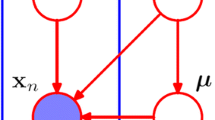Abstract
In this paper a novel approach for the interdependent task of multiple object tracking and scene segmentation is presented. The method partitions a stereo image sequence of a dynamic 3-dimensional (3D) scene into its most prominent moving groups with similar 3D motion. The unknown set of motion parameters is recursively estimated using an iterated extended Kalman filter (IEKF) which will be derived from the expectation-maximization (EM) algorithm. The EM formulation is used to incorporate a probabilistic data association measure into the tracking process. In a subsequent segregation step, each image point is assigned to the object hypothesis with maximum a posteriori (MAP) probability. Within the association process, which is implemented as labeling problem, a Markov Random Field (MRF) is used to express our expectations on spatial continuity of objects.
Preview
Unable to display preview. Download preview PDF.
Similar content being viewed by others
References
Bar-Shalom, Y.: Tracking and data association. Academic Press Professional, Inc., San Diego (1987)
Blackman, S., Popoli, R.: Design and Analysis of Modern Tracking Systems. Artech House, Boston (1999)
Molnar, K., Modestino, J.: Application of the EM algorithm for the multitarget/multisensor tracking problem. IEEE Trans. Signal Processing 46(1), 115–129 (1998)
Longuet-Higgins, H., Prazdny, K.: The interpretation of a moving retinal image. Proceedings of Royal Society of London 208, 385–397 (1980)
Logothetis, A., Krishnamurthy, V.: Expectation maximization algorithms for map estimation of jump markov linear systems. IEEE Trans. Signal Processing 47(8), 2139–2156 (1999)
Dempster, A., Laird, N., Rubin, D.: Maximum likelihood from incomplete data via the EM algorithm. Journal Royal Statistical Society B 39(1), 1–38 (1977)
Green, P.: On use of the EM algorithm for penalized likelihood estimation. Journal Royal Statistical Society 52(3), 443–452 (1990)
Besag, J.: Spatial interaction and the statistical analysis of lattice systems. Journal Royal Statistical Society (2), 192–236 (1974)
Chiuso, A., Soatto, S.: Motion and structure form 2d motion causally integrated over time: Anlaysis. IEEE Trans. Robotics and Automation (2000)
Sibley, G., Sukhatme, G., Matthies, L.: The iterated sigma point kalman filter with applications to long range stereo. In: Proceedings of Robotics: Science and Systems, Philadelphia, USA (August 2006)
Boykov, Y., Veksler, O., Zabih, R.: Fast approximate energy minimization via graph cuts. IEEE Trans. PAMI 23(11), 1222–1239 (2001)
Author information
Authors and Affiliations
Editor information
Editors and Affiliations
Rights and permissions
Copyright information
© 2009 Springer-Verlag Berlin Heidelberg
About this paper
Cite this paper
Bachmann, A. (2009). Applying Recursive EM to Scene Segmentation. In: Denzler, J., Notni, G., Süße, H. (eds) Pattern Recognition. DAGM 2009. Lecture Notes in Computer Science, vol 5748. Springer, Berlin, Heidelberg. https://doi.org/10.1007/978-3-642-03798-6_52
Download citation
DOI: https://doi.org/10.1007/978-3-642-03798-6_52
Publisher Name: Springer, Berlin, Heidelberg
Print ISBN: 978-3-642-03797-9
Online ISBN: 978-3-642-03798-6
eBook Packages: Computer ScienceComputer Science (R0)




